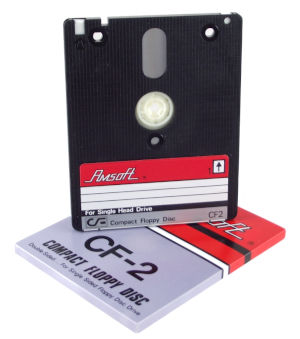
|
This site is running on a 286 PC, booted and served
entirely from a 90mm floppy disk. See current
server stats. All content on this site is provided by the Museum of Obsolete Media, curated by Jason Curtis. My sincerest thanks to Jason for providing me with the worthy challenge of exhibiting his work in the only appropriate way: The Floppy Disk Museum: The Bootable Floppy edition! |


The 3-inch floppy disk (also known as the Compact Floppy or CF2) was designed by Hitachi, Matsushita and Maxell, and introduced in 1982.
3-inch floppy disks were double-sided in nature, and needed to be turned over in single-sided drives to use the other side. To distinguish the two sides, they were labelled 'A' and 'B' and the disk had independent write-protect switches. Each side of the disk held 180 KB for a total of 360 KB per disk, or 720 KB for double-density (CF2-DD) disks.
The 3-inch floppy has a more rigid casing than a 3.5-inch microfloppy, and the metal shutter is opened by a sliding plastic tab. The disks are just over 3-inches wide, and nearly 4-inches long (100.0 mm x 80.0 mm x 5.0 mm).
The main user of the 3-inch disk format was the UK-based Amstrad company, that used the 3-inch floppy for their CPC and PCW ranges from 1985 and later used it for the Sinclair ZX Spectrum +3. It was also used for the Oric-1 and Oric Atmos, Tatung Einstein, and some MSX systems, as well as some more obscure computers. External drives produced by AmDisk were also available for computers such as the TRS-80 and Apple II.
The disks were expensive due to the complex case design. The rival 3.5-inch microfloppy disk was chosen by Apple for use in the Macintosh in 1984, and in 1987 IBM used it in the PS/2 range (in it's high-density version) making it the standard for floppy disk drives.
In 1991, Amstrad switched to the 3.5-inch high-density microfloppy for the PCW range.